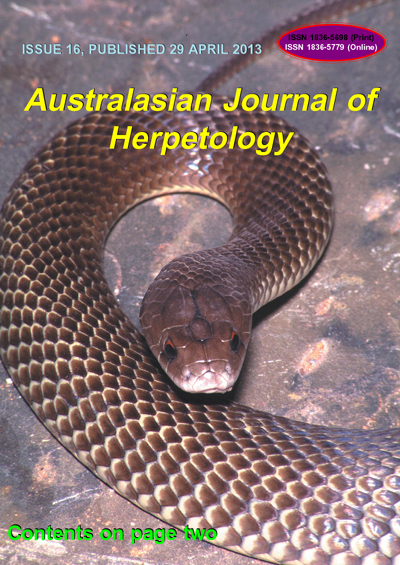
Media
release - May 2013 - Australia gets a new deadly snake!
A new species of deadly brown snake has been discovered in the Northern Territory.
Intermediate in form between the King Brown and Common Brown Snakes, the new species is currently only known from the top end.
Recently named “Cannia (Pailsus) hoserae”, the snake is the fourth species to be named within a group known as the “Pygmy Mulga Snakes”. These are dangerously venomous cousins of the much feared King Brown Snakes.
They are readily separated from both King Brown (Cannia/Pseudechis) and Common Brown Snakes (Pseudonaja) by consistent scalation differences on both head (rostral scale) and tail (subcaudals).
While superficially similar to three other species from WA, Queensland, and New Guinea, all only discovered and named by scientists in 1986, 1998 and 2000, two separate molecular studies published in 2005 showed this new species to be different from all the others, thereby necessitating the new description.
The paper naming the snake was published in Australasian Journal of Herpetology (Issue 16) last month. The new species attains about a metre in length as opposed to up to two or three metres for Common and King Brown Snakes. The new species is also considerably more slight in build. It was named “Cannia (Pseudechis) (Pailsus) hoserae” in honour of Raymond Hoser’s wife, Shireen Hoser for her work with reptile education in Melbourne.
Recently a man died from a bite from a misidentified brown coloured snake in Darwin, the seventh Australian snakebite death in the last 9 months. The discoverer of the new species, Raymond Hoser said “part of the underlying problem is that there are several similar but different large brown and deadly snakes found across the top end. Different species require different anti-venoms and the wrong one won’t help in the event of a bite. For some species there is no anti-venom manufactured, necessitating use of that with the closest match”.
As a result, Hoser stresses the importance of the “keep away from all snakes” message.
Notwithstanding the snake avoidance message an increasing number of snakebite deaths in recent years have been of people calling themselves professional snake handlers. To remove this inherent risk, in 2003 Hoser developed a world first safe and effective means to surgically remove venom glands from snakes used in displays. As a result, numerous snake handlers lives have already been saved because they have not been envenomated when bitten during displays.
The same paper last month also named several species and subgenera of non-venomous “Blind Snakes” from northern Australia, again based on both morphological and molecular evidence.
Hoser said “I know of at least four more undescribed Blind Snake species in north-west Australia and have little doubt that actual number of undescribed species may be far greater”. Globally more than 200 new reptile species were named last year (2012), which is a record for the group. There are currently over 10,000 recognized species of reptile globally and estimates of another 2,000 unnamed are regarded as conservative. Most of these are lizards. New molecular methods, involving the analysis of mitochondrial DNA in particular, are making it easier to audit wide ranging species and identify unnamed forms.
Further
details: Phone: 0412-777-211 (within Australia).
A photo of the new species may be downloaded here:
http://www.smuggled.com/Pseudechis-pailsus-hoserae.jpg
Caption details: Photo Snake Man Raymond Hoser.
This media release is posted online here:
http://www.smuggled.com/Pailsus-New-from-NT-12-May-2013-1.htm
Other media releases from smuggled.com, snakebusters, snake man.![]()